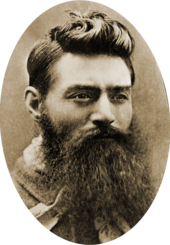Charles Nettleton
Charles Nettleton | |
|---|---|
Victoria , Australia | |
| Occupation | Photographer |
Charles Nettleton (1826–1902) was an Australian photographer who worked in
Early life
Nettleton was born in Northern England in 1826, son to George Nettleton. In 1854, looking for a change of weather or scenery, he moved to Victoria with his wife Emma (née Miles). Together they had seven daughters and three sons.[1][2]
Career

After Nettleton arrived in Victoria in 1854 he was employed at the photographic studio of Duryea and McDonald. On 12 September 1854, Nettleton photographed the first steam train journey in Australia, between Melbourne and
As a result of capturing that landmark event, Nettleton was invited by the
In 1858, Nettleton opened his own studio, after which he attempted portrait photographs, but due to their poor quality, he decided to concentrate on his views of Melbourne and environs.[3]
Nettleton photographed soldiers being sent to the
In the 1860s, he became a police photographer and worked for 25 years in that department, finishing his duty in the 1880s.[4] In 1880, he took a photographic portrait of Ned Kelly, the famous Australian bushranger and outlaw, the day before his execution.[1]
In 1868, Nettleton published the first souvenir albums of that type for public sale in Australia. One album consisted of 12 views of Melbourne.[2] Nettleton designed large album prints of his views of shipping in the mid to late 1880s. He also captured views of Queen's Wharf in Melbourne, "The Drops" at the Coliban waterworks, and the waterworks at Geelong, Malmsbury and Yean Yean. Because photo-mechanical printing processes were rare at the time, all of Nettleton's albums are prints of his actual photographs. These albums can now be found in the collections of libraries and museums throughout Australia.

In 1890, Nettleton decided to close his studio and retire, because of the introduction of
Exhibitions
In the 1860s, Nettleton was becoming well known as a photographer, and he created photograph albums which were shown in a number of exhibitions. His first successful exhibition was held in London in 1862.[1] Other exhibitions took place in Dublin in 1865 and Paris in 1867.[4] In 1879, his final exhibition was in his home country, in a Sydney Exhibition.[4]
Nettleton's prints were generally of two sizes: 8 in × 6 in (200 mm × 150 mm) and 15 in × 12 in (380 mm × 300 mm).[3]
Techniques

Nettleton used the wet plate process for his images, also known as the collodion process.[4] The simpler dry plate process was being increasingly adopted by the mid-1880s. The new technique adversely affected Nettleton's business using the wet plate process, and he eventually decided to retire.
Nettleton knew how to capture a photograph professionally. He was able to adjust complicating structures with his understanding of depth of field, creating very clear detail.[citation needed] He liked going to high points so he could take panoramic views.[3] One of his panoramas was used as the basis for a lithograph by the firm of De Gruchy and Leigh.[2]
Nettleton's skill was displayed in the sharp delineation in his photos taken at six seconds exposure.[1] Using that technique he was able to photograph soldiers and horses involved in the New Zealand Wars and capture them as still photographs.[3]
References
- ^ a b c d e f g h i Gittins, Jean (13 April 2015). "Nettleton, Charles (1826-1902)". Australian Dictionary Of Biography. Retrieved 13 April 2015.
- ^ a b c Newton, Gael (1988). Shades Of Light. Canberra: Australian National Gallery. pp. 38–44.
- ^ a b c d e Cato, Jack (1977). The Story Of The Camera In Australia (2nd ed.). Institute Of Australian Photography. pp. 29–33.
- ^ a b c d e "Photograph Album- 'Melbourne Photographs', Charles Nettleton, Melbourne, Victoria, 1890s". Museum Victoria. Archived from the original on 28 March 2015. Retrieved 19 April 2015.
